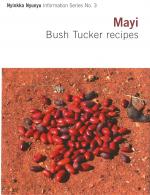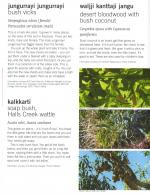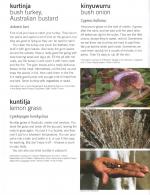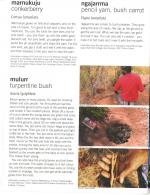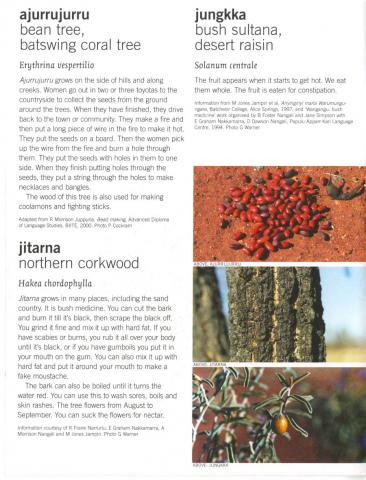Mayi: Bush Tucker Recipes (page 2)
ajurrujurru (bean tree, batswing coral tree; Erythrina vespertilio)
Grows on the side of the hills and along creeks. Women go out in two or three toyotas to the countryside to collect the seeds from the ground around the trees. When they have finished, they drive back to the town or community. They make a fire and put a long piece of wire in the fire to make it hot. They put the seeds on the board. Then the women pick up the wire from the fire and burn a hole through them. They put the seeds with holes in them to one side. When they finish putting holes through the seeds, they put a string through the holes to makes necklaces and bangles. The wood of this tree is also used for making coolamons and fighting sticks.
R. Morrison Juppurla, Bead Making, Advanced Diploma of Language Studies, BIITE, 2000. Photo P. Cockram
jitarna (northern corkwood; Hakea Chordophylla)
Jitarna grows in many places, including the sand country. It is bush medicine. You can cut the bark and burn it till it's black, then scrape the black off. Your grind it fine and mix it up with hard fat. If you have scabies or burns, you rub it all over your body until it's black, or if you have gumboils you put it in your mouth on the gum. You can also mix it up with hard fat and put it around your mouth to make a fake moustache. The bark can also be boiled until it turns the water red. You can use this to wash sores, boils and skin rashes. The tree flowers from August to September. You can suck the flowers for nectar.
R. Frank Narrurlu, E. Graham Nakkamarra, A. Morrison Nangali and M. Jones Jampin, Photo G. Warner
jungkka (bush sultana, desert raisin; Solanum centrale)
The fruit appears when it starts to get hot. We eat them whole. The fruit is eaten for constipation.
M. Jones Jampin et al, Anyinginyi marla Warumungu-ngara, Batchelor College, Alice Springs, 1997; and 'Wangangu: bush medicine' work organised by B Foster Nangali, Papulu Apparr-Kari Language Centre, 1994. Photo G. Warner
